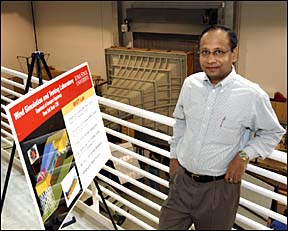|
|
|
|
|
April 18, 2003Windy work
Partha Sarkar wants to bring the winds of change to building codes. More specifically, to construct buildings that have a better chance of withstanding tornados and other wind-damaging events. Sarkar, who holds the T.A. and Grace Miller Wilson Endowed Chair in Engineering and is an associate professor of aerospace engineering and civil engineering, will begin his quest modestly, by building a novel type of wind tunnel in Howe Hall. Wind tunnels traditionally are big, clunky frames of steel supporting large rectangular air ducts. Within the air ducts resides a massive fan, which circulates air in the confined, controlled environment of the tunnel. What Sarkar has in mind is nothing like that. Indoor tornado His tornado and microburst simulator is cylinder-shaped, with a large opening at the bottom and a nearly complete enclosure at the top. Within the 18-foot diameter wide steel cylinder will be a concentric 1-foot wide duct. This duct will circulate vortexed (swirling) air that is pushed down from the top, through the duct, into the opened bottom. The swirling air then will be sucked up through the top, through a 6-foot diameter fan inside the cylinder, essentially simulating a tornado from the bottom up. With a flip of a switch, the same simulator will generate a microburst (powerful downdraft). In concert with this fresh wind tunnel design, the entire simulator will move along a steel girder frame powered by a 5-ton crane. The result, Sarkar said, will be a wind tunnel that can replicate a moving tornado or microburst as it sweeps over a landscape -- in this case a landscape populated with models of buildings. "Our idea is to have a facility for the 21st century, one that takes wind tunnels to the next level," Sarkar said. The tornado and microburst simulator -- on which Sarkar is collaborating with Fred Haan of aerospace engineering, Bill Gallus of geological and atmospheric sciences, and Josh Wurman of BITNET Inc., Boulder, Colo. -- is one of two wind tunnels Sarkar has designed and whose construction he will oversee this summer. The other facility, the aero/atmospheric boundary layer wind tunnel, will have a more conventional design and will be one of the largest of its type. It will produce winds in the traditional fashion, though at higher speeds (up to 110 mph) than similar tunnels. It also will be able to produce variable wind gusts, a feature not found in current wind tunnels. Together, the tunnels form the Wind Simulation and Testing Laboratory that will just about fill up the entire west-end leg of Howe Hall. The laboratory also should fill in some of the holes in current tornado and wind research, and, Sarkar hopes, affect building codes. Simulating gales, gusts Conventional wind tunnels produce "straight-line winds," which are most useful in understanding the fluid-structure interaction between surfaces and air, and important if you are designing airplanes or a more efficient automobile. Test results from conventional wind tunnels also have been used to develop building codes. But Sarkar said conventional tunnels may not provide values that are truly representative of extreme wind events, like a hurricane. "Wind tunnels today can simulate straight-line winds very well, but that isn't very representative of the winds of a hurricane, which has gusting winds with large variations in wind direction or turbulence," Sarkar said. "In a tornado, where the vortex is relatively small compared to a hurricane, the rotating flow has a different effect on structures. It produces much higher pressures, or loads, than what you would get with the straight-line winds produced in a regular wind tunnel." Knowing he can't perfectly reproduce something as complex as a tornado, Sarkar said the new lab more faithfully will produce the major elements of one. The new facility, for example, more accurately will simulate what happens when a twister hits a building, producing the gale forces and high pressures the building experiences. In addition, because the wind tunnel moves the tornado, the actual simulation is more realistic. Ultimately, Sarkar said his research could result in changes to building codes, which he said do not really take into account the true wrath of a tornado. That, he added, will ruffle some feathers. "It will create controversy," he promises of the tornado simulator research. "It will not make the construction people happy." Yet, Sarkar thinks the stakes are high enough to warrant a new look at an old foe. Each year, 80 lives are lost and $850 million in damage occurs in this country due to natural disasters, he said. Of that, 70 percent is caused by wind, and a large chunk of the wind damage is due to tornados. "People keep saying we can't do anything about this. We can't design buildings that are tornado-proof," Sarkar said. "I agree to an extent. But we can't just sit back and not do anything about it. "With this facility, we will be in a much better position so that maybe in 10 years we will have building codes that consider tornado and microburst winds," he added. "If we don't start now, we won't get there." |
|
Ames, Iowa 50011, (515) 294-4111 Published by: University Relations, online@iastate.edu Copyright © 1995-2003, Iowa State University. All rights reserved. |
